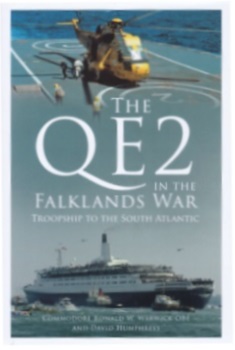When the Merchant Navy goes to war
The QE2 in the Falklands War, by Commodore Ronald Warwick and David Humphreys
 When the Cunard liner Queen Elizabeth 2 became a STUFT (ship taken up from trade) in the 1982 Falklands War, the vessel's civilian crew were up for the challenge. Their mission was to deliver hundreds of squaddies to the South Atlantic, and most volunteered for the voyage, either serving in their usual roles or something similar – like the onboard hairdresser who switched from perms and sets to military cuts.
When the Cunard liner Queen Elizabeth 2 became a STUFT (ship taken up from trade) in the 1982 Falklands War, the vessel's civilian crew were up for the challenge. Their mission was to deliver hundreds of squaddies to the South Atlantic, and most volunteered for the voyage, either serving in their usual roles or something similar – like the onboard hairdresser who switched from perms and sets to military cuts.
However, it was not simply a question of inviting the troops onboard and setting off. Major work was needed to reinforce the open decks so large helicopters could land on them, not to mention converting cabins to accommodate more personnel and installing protective coverings so the liner's luxurious fixtures and fittings weren't damaged by military boots.
Much of this work was carried out in just eight days at the vessel's berth in Southampton, but carpenters, engineers and painters in the QE2's crew and army passengers were kept busy throughout the time at sea. Notably, after the vessel had left port with huge fanfare and media interest, it had to anchor quietly on the other side of the Isle of Wight for emergency repairs to the boilers.
This wryly-related story is typical of the crew memories in The QE2 in the Falklands War, which is authored by Nautilus member Ronald Warwick and his former colleague David Humphreys. Commodore Warwick famously went on to be the master of the QE2, but in 1982 he was chief officer on the vessel, and therefore served in the South Atlantic.
Many of the memories in the book come directly from Warwick and Humphreys themselves, but they have also done an excellent job of collecting information from fellow veterans and other historical sources. We hear from all kinds of ranks and roles, and there are some nice period details, such as the pub in Southampton docks offering the crew and soldiers a 20p discount on pints before they left.
Of course, war is a serious business, and the QE2 had an important job to do, taking troops to Ascencion Island and South Georgia and bringing home the survivors of the sunken warships HMS Ardent, HMS Antelope and HMS Coventry. The vessel's doctors and nurses cared for injured servicemen on that homeward voyage, with such good effect that only one patient needed further hospital care back in Britain. Fine work by the crew, and a well-written history that does them justice.
The QE2 in the Falklands War: Troopship to the South Atlantic
By Commodore Ronald Warwick and David Humphreys
History Press, £25
ISBN: 978 18039 97384
Buy this book in the Nautilus Bookshop
While you're there, why not browse the rest of the titles in our unique maritime bookshop, which sells all the books reviewed on these pages.
Buy nowMore Books
The precarious path from piracy to prosperity
The Resurrected Pirate, by Craig S ChapmanThe Resurrected Pirate is a remarkable story told in an engaging way, illustrating for the modern reader the desperately narrow passage between life and death that a seafarer in this period might have to navigate.
Carving out a career
Ships' Figureheads: Famous Carving FamiliesThe decoration of ships with figureheads was a way to present the might of military and mercantile power for centuries. These days, the skills needed to make these sculptures are kept alive by experts such as Andrew Peters, who has worked on restoration projects such as the Cutty Sark tea clipper.
Knotty problems solved
The Knot Bible: The Complete Guide to Knots And Their Uses by Nic ComptonKnot-tying is a vital competency skill for seafarers, and this expanded edition of The Knot Bible by Nic Compton offers guidance on over 200 knots and their practical uses.
Why it's nice to splice
Splicing modern ropes, 2nd edition: a practical handbook by Jan-Willem PolmanSplicing rope is as an essential skill for seafarers as tying a knot, but some skills are disappearing. This definitive guide on why splicing gets more from your rope is a great stocking filler for all boaters, whether recreational or commercial.
